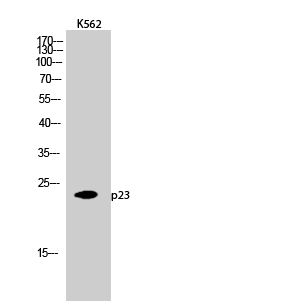p23 Antibody (OASE00083)
OASE00083
ApplicationsImmunoFluorescence, ImmunoPrecipitation, Western Blot, ELISA, ImmunoCytoChemistry, ImmunoHistoChemistry, Other Application
Product group Antibodies
TargetPTGES3
Overview
- SupplierAviva Systems Biology
- Product Namep23 Antibody (OASE00083)
- Delivery Days Customer23
- ApplicationsImmunoFluorescence, ImmunoPrecipitation, Western Blot, ELISA, ImmunoCytoChemistry, ImmunoHistoChemistry, Other Application
- CertificationResearch Use Only
- ClonalityMonoclonal
- Clone IDJJ6
- Concentration1 mg/ml
- ConjugateUnconjugated
- Gene ID10728
- Target namePTGES3
- Target descriptionprostaglandin E synthase 3
- Target synonymsP23, TEBP, cPGES, prostaglandin E synthase 3, Hsp90 co-chaperone, cytosolic prostaglandin E synthase, cytosolic prostaglandin E2 synthase, progesterone receptor complex p23, prostaglandin E synthase 3 (cytosolic), telomerase-binding protein p23, unactive progesterone receptor, 23 kD
- HostMouse
- IsotypeIgG1
- Scientific Descriptionp23 is a highly conserved ubiquitous protein, known to have an important function as a cochaperone for the HSP90 chaperoning system (1). Studies have revealed that p23 is a small protein (18 to 25 kDa) with a simple structure (2, 3). p23 does not have any structural homology with any other known proteins (1). p23 was first discovered as a part of the HSP90-progesterone receptor complex along with HSP70, p54 and p50 (1). p23 is a phosphor-protein, which is highly acidic and has an aspartic acid-rich c-terminal domain (1). Numerous studies have found p23 to be associated with other client proteins like Fes tyrosine kinase (4), the heme regulated kinase HRI (5), hsf1 transcription factor (4), aryl hydrocarbon receptor (4), telomerase (6), and Hepadnavirus reverse transcriptase (7). In spite of several years of study, the exact functional significance of p23 is still not clear (8). p23 is thought to be involved in the adenosine triphosphate-mediated HSP90 binding of client proteins (8). Since many HSP90 client proteins are involved in oncogenic survival signaling, a recent study has concluded p23 to be a promising target in leukemic apoptosis (9). HSP90 and its co-chaperone p23 are certainly among the emerging anti-tumor targets in oncology.
- Storage Instruction-20°C
- UNSPSC12352203






